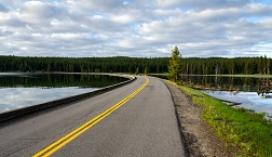States Showcase Award-Winning Approaches to Environmental Stewardship
Transportation projects can have significant environmental impacts on wildlife habitats and ecosystems. Increasingly, agencies are embracing early planning efforts to incorporate environmental stewardship into their projects, helping protect the environment while meeting transportation needs.
In “Setting the Bar for Excellence,” an article in the January/February 2014 issue of the Federal Highway Administration’s (FHWA) Public Roads magazine, Volpe community planner Rachel Strauss discusses innovative approaches that are used to incorporate environmental stewardship into transportation projects. These approaches are highlighted by 13 projects that received FHWA’s 2013 Environmental Excellence Awards.
Strauss was the Volpe project manager for the 2013 Environmental Excellence Awards and worked with the FHWA Office of Project Development and Environmental Review in coordinating the awards.
Streamlining Environmental Compliance
In two of the award-winning projects that were selected as recipients of the Programmatic Agreements category, the states of Oregon and Washington created guidance documents, known as programmatic consultations, that guide agency decision making and help streamline the review process for Endangered Species Act compliance.
The net result: shorter project timelines.
In Oregon, more than 20 projects have followed the expedited compliance process, incorporating environmental considerations earlier in transportation planning, with an overall reduction in consultation timelines of up to 85 percent—equivalent to 170 days. Results in Washington show an almost 90 percent reduction in consultation timelines. This approach to environmental planning is allowing agencies in these two states to implement projects more quickly.
Technology and the Environment
Groundbreaking applications of data and technology are helping improve environmental outcomes.
Technology helps the state of Utah protect its wildlife and reduce animal-vehicle collisions. In a multi-year research study, Utah employed motion-sensing cameras to monitor wildlife crossings, capturing more than 2 million images over 40,000 camera days. Selected as an award recipient in the Environmental Research category, this study produced recommendations and set new standards for crossing structure designs, such as shorter culverts and terrestrial paths for wildlife to travel, that could help prevent future collisions.
“[Utah DOT] engineers found that two of the culvert crossing structures monitored in the study reduced collisions along I–15 by more than 90 percent and paid for themselves in less than 3 years,” the Public Roads article reports.
State highway agencies often face a difficult balancing act between preserving the character of historically significant roadways and performing necessary maintenance to make these roads suitable for modern travel.
In Arizona, to help preserve the unique historical engineering features of the Apache Trail, several federal and state agencies created a geographic information systems inventory of every man-made element on the road. Without a comprehensive inventory of these elements, it was challenging to plan and prioritize needed maintenance operations. The Apache Trail Historic GIS Inventory won an award in the Geospatial Tools, Technology, and Analysis category.
Honoring Innovation
Since 1995, the biennial Environmental Excellence Awards have recognized partners, projects, and processes that use FHWA funding sources to go beyond environmental compliance and achieve environmental excellence.
The next round of Environmental Excellence Awards is slated for 2015.
To find out more about these and other innovative recipients of the 2013 awards, read the full Public Roads article: Setting the Bar for Excellence.
Quick Facts

- Guidance for streamlining environmental compliance reduced project timelines by up to 170 days.
- New wildlife-crossing structures reduced collisions by more than 90 percent and paid for themselves in less than 3 years.
